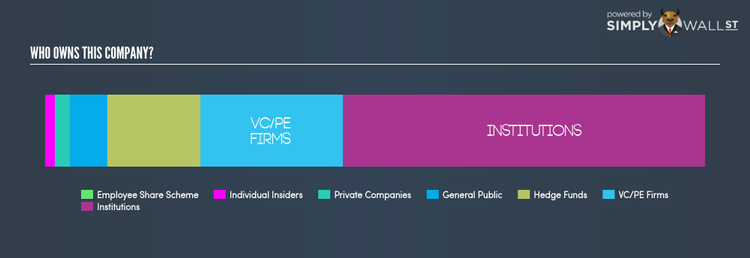Why Hurricane Energy plc’s (LON:HUR) Investor Composition Impacts Your Returns
In this analysis, my focus will be on developing a perspective on Hurricane Energy plc’s (AIM:HUR) latest ownership structure, a less discussed, but important factor. When it comes to ownership structure of a company, the impact has been observed in both the long-and short-term performance of shares. Differences in ownership structure of companies can have a profound effect on how management’s incentives are aligned with shareholder returns, which is why we’ll take a moment to analyse HUR’s shareholder registry. All data provided is as of the most recent financial year end.
See our latest analysis for Hurricane Energy

Institutional Ownership
HUR’s 54.77% institutional ownership seems enough to cause large share price movements in the case of significant share sell-off or acquisitions by institutions, particularly when there is a low level of public shares available on the market to trade. These moves, at least in the short-term, are generally observed in an institutional ownership mix comprising of active stock pickers, in particular levered hedge funds, which can cause large price swings. Considering hedge funds hold a stake of 14.08% in the company, HUR shares may experience high short-term volatility as this class of institutions are frequently found to sell significantly during market-wide shocks. We should dig deeper into the company’s ownership structure to find how the rest of its ownership structure can impact its investment case.
Insider Ownership
Another important group of shareholders are company insiders. Insider ownership has to do more with how the company is managed and less to do with the direct impact of the magnitude of shares trading on the market. With a stake of 1.55%, insiders seem to have some alignment of interest with shareholders. A higher level of insider ownership has been found to reflect the choosing of projects with higher return on investments compared to lower returning projects for the sake of expansion. I will also like to check what insiders have been doing recently with their holdings. Insider buying may be a sign of upbeat future expectations, however, selling doesn’t necessarily mean the opposite as insiders may be motivated by their personal financial needs.
General Public Ownership
With 5.65% ownership, the general public are also an important ownership class in HUR. While this size of ownership may not be enough to sway a policy decision in their favour, they can still make a collective impact on company policies if it aligns with other large shareholders.
Private Equity Ownership
With a stake of 21.62%, private equity firms form another important class of owners in HUR. With a stake of 21.62%, they can influence HUR’s key policy decisions. This is a positive sign for potential investors as these firms play an important role in aligning company policy with shareholder returns.
Private Company Ownership
Another group of owners that a potential investor in HUR should consider are private companies, with a stake of 2.32%. While they invest more often due to strategic interests, an investment can also be driven by capital gains through share price appreciation. However, an ownership of this size may be relatively insignificant, meaning that these shareholders may not have the potential to influence HUR’s business strategy. Thus, investors not need worry too much about the consequences of these holdings.
What this means for you:
I suggest investors seek some degree of margin of safety due to high institutional ownership in HUR, in particular due to the strong presence of active hedge fund investors. This may enable shareholders to comfortably invest in the company and avoid getting trapped in a sustained sell-off that is often observed in stocks with this level of institutional participation. However, ownership structure should not be the only focus of your research when constructing an investment thesis around HUR. Instead, you should be evaluating company-specific factors such as Hurricane Energy’s past track record and financial health. I urge you to complete your research by taking a look at the following:
NB: Figures in this article are calculated using data from the last twelve months, which refer to the 12-month period ending on the last date of the month the financial statement is dated. This may not be consistent with full year annual report figures.
To help readers see pass the short term volatility of the financial market, we aim to bring you a long-term focused research analysis purely driven by fundamental data. Note that our analysis does not factor in the latest price sensitive company announcements.
The author is an independent contributor and at the time of publication had no position in the stocks mentioned.
